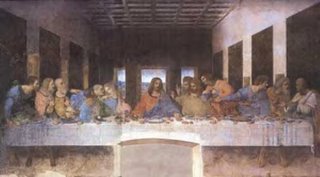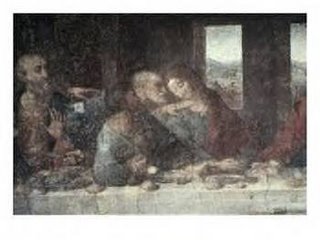At first glance, it's an interesting idea, especially since the person on Jesus' right hand does look effeminate. However, the theory does not hold up under closer examination.
 Take a look at the painting:
Take a look at the painting:To begin with, there are 12 people in the painting other than Jesus. Count them! They are in four groups of three each; six men on each side of Jesus. So if one of them was Mary Magdalene, then one of the 12 disciples is missing! Da Vinci often painted young men to look effeminate. In his early sketches, da Vinci said the disciple next to Jesus was John. This fits with the purpose of the painting, which was to visually depict the scene described in the New Testament gospels, when Jesus announced that he was being betrayed.
Read this passage from John 13:21-25 (Holman Christian Standard Bible):
When Jesus had said this, He was troubled in His spirit and testified, "I assure you: One of you will betray Me!"
The disciples started looking at one another-- uncertain which one He was speaking about. One of his disciples, the one Jesus loved, was reclining close beside Jesus. Simon Peter motioned to him to find out who it was He was talking about. So he leaned back and asked Him, "Lord, who is it?"

Take a look at this closer view of the painting. John referred to Himself as "the one Jesus loved" in his own gospel (see John 19:26; 20:2; 21:7, 20). John was also a younger disciple, who lived much longer and ended up writing the Revelation as an older man. It is John who was "close beside Jesus." Then notice the gospel says that Simon Peter motioned to him to find out who Jesus was talking about. In the painting, you can see Peter motioning to the young John, just as the gospel says.
The painting is not trying to reveal a secret code about Mary Magdalene. It is trying to depict the horror of the moment when Jesus was betrayed.
Dan Brown doesn't get it-- or does he, with his own form of betrayal of Christ?
3 comments:
HA HA HA
Another absurdity. Many painting of the time, especially Da Vinci's, depicted men, especially young men, as very femenine, and it's not as though that's a secret, it's one of the things most comment on when defining that particular period in art history.
And beyond that, how did Da Vinci know? He snuck over to N America and found some gold plates, didn't he? And Nero played a lyre while he melted them down into rings to be worn by S. Louisiana hoo-doo practitioners!? What?!!
This is quickly becoming something that I (noted without having read the book) can only see as Mr. Brown's attempt to cause a stir. It's too silly to actually believe, so his purpose really must have been just to get a reaction. And you're giving it to him.
To argue with someone is to accept that they have a reasonable premise upon which to base their arguement. Do you really see one here?
Sadly, a lie, even a ridiculous one like this, is often believed if repeated enough, and Dan Brown's lie has been repeated each time one of the 46 million copies of his book has been read. And often people believe a lie if the other side refuses to respond. Silence is often taken as acknowledgement. So Christians are responding by pointing out the truth.
I obviously can claim expert status on few things, but in my experience arguing validates. The people who will take silence as agreement are looking for a reason to discount anything but what they want to believe. There's no convincing those people.
Post a Comment